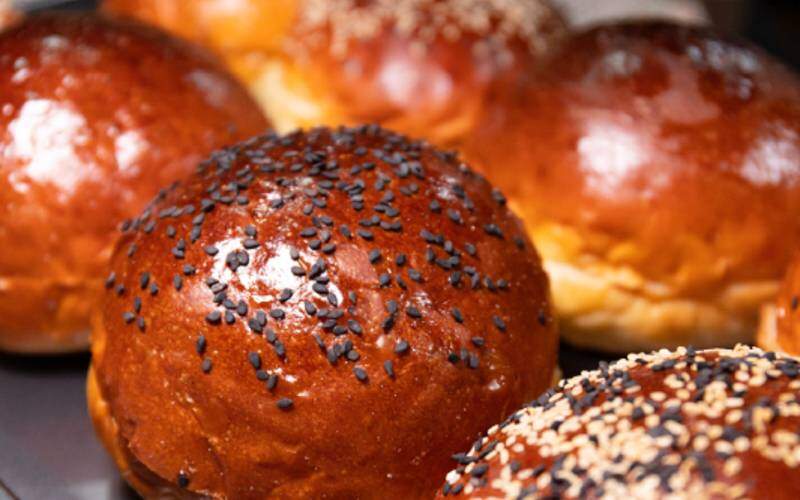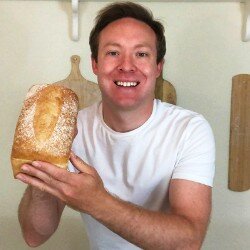
What Is The Reason For Sugar In bread? Is It Essential?

It’s a common misconception that sugar is solely added to make food and drinks sweet. While sugar does sweeten food, it holds many more functions in bread making than just as a sweetener. So, “Why is there sugar in bread?”, “What does sugar do to bread?” and “Is it essential to include sugar in a bread recipe?”. I asked myself the same questions, and here’s what I found out.
Why bread has sugar
Sugar is included in many types of bread as it serves many functions outside of simply adding sweetness. Let’s take a look at each one:
Supplies the yeast with food
Yeast cells are living organisms which need food for their metabolism. Sugar, or its scientific name, sucrose, is a disaccharide. It’s a bond of two hexose sugars, fructose and glucose.
Yeast produces enzymes that break the bonds to separate the hexoses. Fructose and glucose can now enter glycolysis, where they go on to produce carbon dioxide and water through the Krebs cycle, or carbon dioxide and ethanol in the alcoholic fermentation pathway.
In a bread dough without additional sugar, enzymes break down starches (chains of sugars) in the flour into disaccharides for the yeast to process. But, with the addition of table sugar in bread dough, yeast operates at a faster rate as it has sucrose already available.
The extra sugar leads to a rapid release of carbon dioxide gas and therefore a faster-rising bread dough.
Reduces ethanol production
If sugar and oxygen are available, yeast will engage in aerobic respiration to produce C02.
But when sugar and oxygen are depleted, yeast switches from aerobic respiration to anaerobic respiration.
In standard yeast bread, anaerobic respiration leads to alcoholic fermentation. Instead of just CO2, half of the sugars processed by the yeast will ferment and produce ethanol (alcohol).
During baking, the majority of the ethanol produced evaporates, leaving behind a beautiful aroma of burning and raw alcohol to flavour the bread.
Adding sugar to the recipe will provide food for the yeast, which when combined with oxygen forms a dough that rises twice as fast and makes a lighter-tasting bread.
Note: Aerobic respiration is more efficient at producing carbon dioxide than anaeroci respiration (ethanol fermentation). This means that your bread dough will rise faster and benefit from a more significant gain in the oven spring.
Adds sweetness

Not all of the sugar gets consumed by yeast.
The combination of table sugar with sugars derived from the breaking down of moistened flour can produce a surplus of sugar for yeast.
Excess sugars not processed by the yeast have the potential to provide sweet flavours in the bread. Though not all sugars taste sweet, glucose and fructose in table sugar do make bread taste sweeter.
Improves texture
The improvements in texture occur as sugar tenderises the gluten strands.
Dough containing plenty of sugar builds strong bonds with water molecules. The bonds prevent water from being available to the gluten and the yeast (called osmotic stress). This produces close-knit gluten bonds, which reduce the dough’s ability to stretch.
As the dough is not as stretchy, sugar in bread leads to a softer textured crumb.
Adding a small amount of sugar will result in a compact breadcrumb, great for rolls and dinner bread.
A significant amount of sugar in dough produces a light, fluffy texture, like in cakes, brioche and other pastries.
Improves moistness and reduces staling
Sugar retains water which makes baked goods moist.
It also locks in the moisture in the crumb structure, slowing the rate at which water can escape.
By retaining moisture better, the enriched bread keeps fresher for longer.
Flavour enhancer
Who doesn’t love those deliciously sweet brown edges of the bread, right?
Well, this browning is mainly due to Maillard’s reactions. These enzymic reactions occur when proteins are heated in the oven.
The inclusion of sugar in bread increases caramelisation alongside Maillard reactions to add further colour and sweet notes to the crust. A smoky aroma is also left to perfume the loaf.
How sugar changes bread dough
Sugar can have a significant effect on the dough used in bread. It improves the texture and colour of any baked good, as well as extends freshness.
But (arguably), the most prominent role of sugar is providing food to accelerate yeast activity.
Sugar can speed up the rise time during the proofing period so you should be careful not to add too little or too much.
Straying far away from a recipe can have a negative effect on your dough. I use only a little in my beginner’s bread recipe, just enough to provide a bit of extra food, but not enough to cause it to violently create gas!
The impact of using less sugar
Yeast feeds on sugar to produce carbon dioxide gas that will make the dough rise. So, if there’s less sugar, the rising process will be slower, and fewer of the mentioned effects will be prominent.
The impact of too much sugar
Adding too much sugar to the dough can also slow down or inhibit yeast activity as sugar absorbs water.
When there is too little water to conduct osmosis (the passing of nutrients between cells), yeast activity slows.
In severe cases, the yeast becomes dehydrated, and gas production is halted.
Bread dough is high in sugar when it contains more than 1/2 cup of sugar for every 4 cups of flour or above 10% as a baker’s percentage of the flour.
When adding this much sugar to bread dough, you will need to use more yeast (3%) or switch to an osmotolerant yeast.
What is osmotolerant yeast?
Sugar creates osmotic pressure in bread dough which slows down the effectiveness of the yeast.
A little bit (less than 5%) of sugar will make a minimal impact on gas production. But expect it to slow when using more than 10% sugar due to osmotic pressure.
Whilst it is possible to add more yeast to the recipe to compensate for this, the bread can take on the odour and taste of yeast.
The best solution is to use osmotolerant yeast
Osmotolerant yeast is a special type of yeast that copes well under osmotic stress.
It’s more expensive than standard yeast types and only comes in a dried instant yeast format. Being dried, osmotolerant yeast keeps for a reasonably long time.
Osmotolerant yeast has extra potency, which means you can make sweet bread such as doughnuts, challah and panettone with ease and consistency.
Is there a lot of sugar in bread?
The amount of sugar in bread varies by its different types. Most sliced bread contains about 2-4% of sugar content.
In the majority of cases, the majority of sugar found in bread is naturally occurring.
Raw flour contains naturally occurring sugars, with approximately 1.4-2.1g for every 100g of flour.
As more starch gets broken down into simpler sugars, the amount of sugar immediately absorbed when digested is higher.

Flour is made from grains, composed mainly of starch, protein, dietary fibre, and minerals. The amount of sugar in raw flour depends on the grain variety and its growing conditions.
It’s pretty common nowadays to see sugar as an ingredient in bread. With all the benefits of adding sugar, you can see why sugar is used in commercial production.
Although, the extra calories and quick production aren’t good for us!
Is white bread full of sugar?
White bread is high in carbs and low in fibre. This combination can result in higher blood sugar levels.
Besides that, health experts don’t advise that we consume a lot of white bread because:
- It has fewer nutrients compared to other types of bread.
- It’s digested quickly, and the sugars will enter our bloodstream rapidly, and if the energy is not consumed, the unused energy will turn into fat.
- It doesn’t contain as much fibre as what is found in whole wheat bread. This means your body won’t feel as satisfied as if you ate the latter. Fibre is essential for a healthy digestive system and controls blood sugar levels.
- It often has added sugars, leading to weight gain and increased risk of diabetes and heart disease.
Some types of bread may contain more sugar than you’d expect. If you want to make sure that you’re eating healthy, always carefully read the nutrition facts on the label.
Is adding malt to bread the same as sugar?
Malt is made by soaking barley in water until it sprouts, drying and grinding it to flour. It comes in two forms, non-diastatic and diastatic.
Non-diastatic malt is a sweetening agent. It isn’t the same as sugar but can be a form of sweetener in syrup form.
It has a distinct flavour, and it’s also used for making many yeast-leavened baked products.
Compared to other sweeteners, malt is considered more nutritious, so some bakers prefer to use it when making bread.
Diastatic malt flour is regularly used to add more of the enzyme called alpha-amylase. Using it increases the rate at which starch is broken down into simpler sugars.
Malt flour is perfect for poor-performing flour and provides natural sugars in bread without adding extra sugar.
Only a little is required. Overuse can cause a sticky bread texture.
Malt is available in the form of:
- Non-diastatic malt flour
- Diastatic malt flour
- Malt extract
- Malt syrup
Using sugar in bread – Conclusion
Today we’ve learned all about the impact of sugar in bread dough, what it does and what too much of it does! I’m sure you have suspected a few of them, but hopefully, you’ve learned one or two new impacts of adding sugar. I know I have! Let me know in the comments below what you found helpful and perhaps what you’ll try in the future.
Frequently asked questions about adding sugar to bread dough
If you’ve enjoyed this article and wish to treat me to a coffee, you can by following the link below – Thanks x

Hi, I’m Gareth Busby, a baking coach, senior baker and bread-baking fanatic! My aim is to use science, techniques and 15 years of baking experience to make you a better baker.
Table of Contents
Related Recipes
Related Articles
Latest Articles
Baking Categories
Disclaimer
Address
53 Greystone Avenue
Worthing
West Sussex
BN13 1LR
UK







